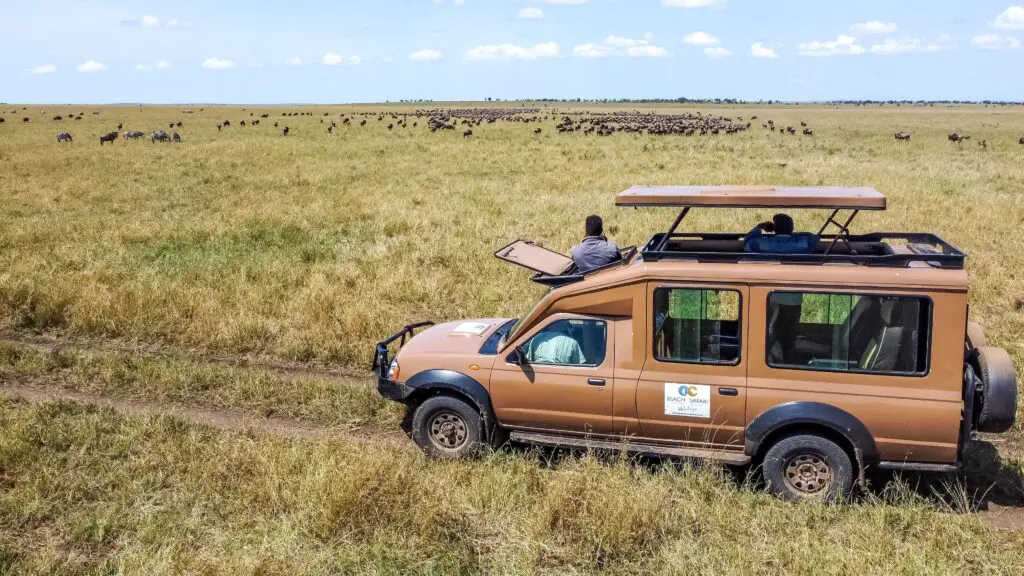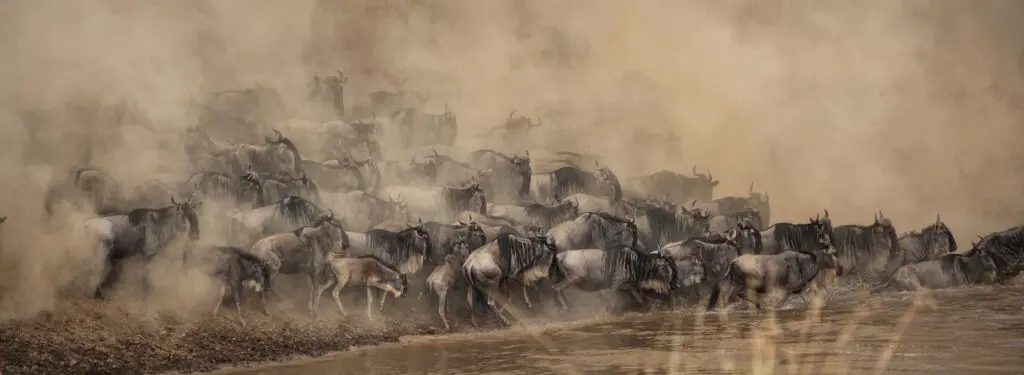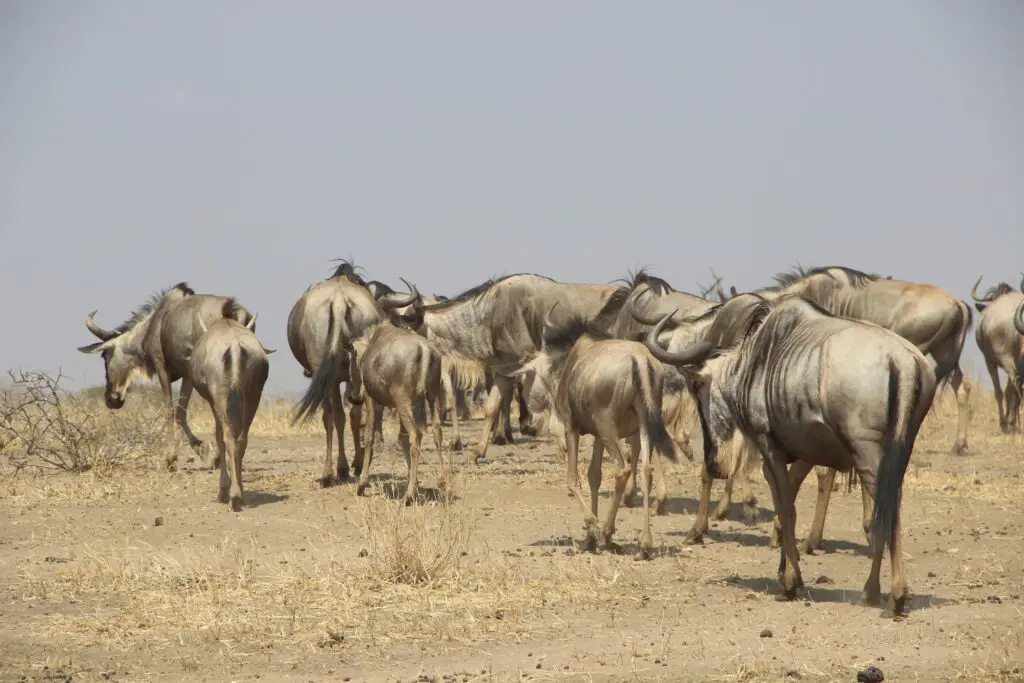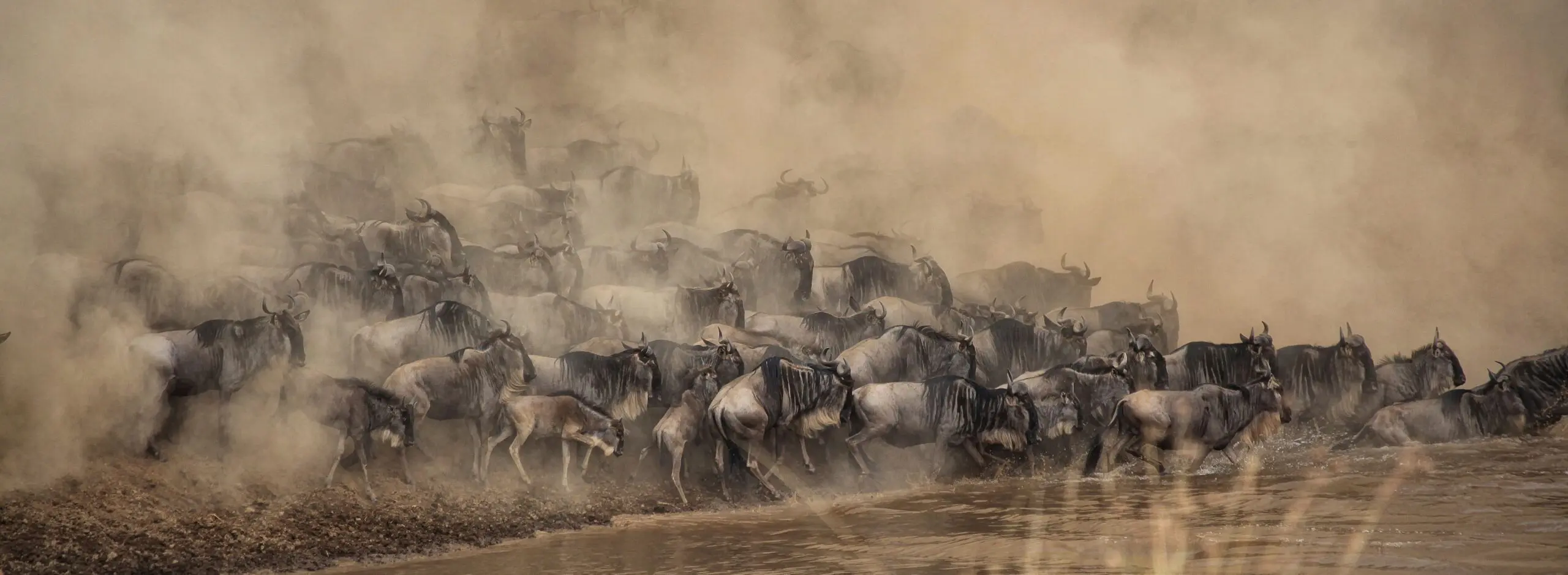
The great migration
The Great Migration is an annual natural phenomenon where more than two million wildebeests and zebras migrate between the Serengeti and Maasai Mara. The herds follow the rhythm of the seasons, searching for fresh grass and water, crossing crocodile-filled rivers, and giving birth to their young around the Lake Ndutu area. The best travel time depends on which moment you want to experience.
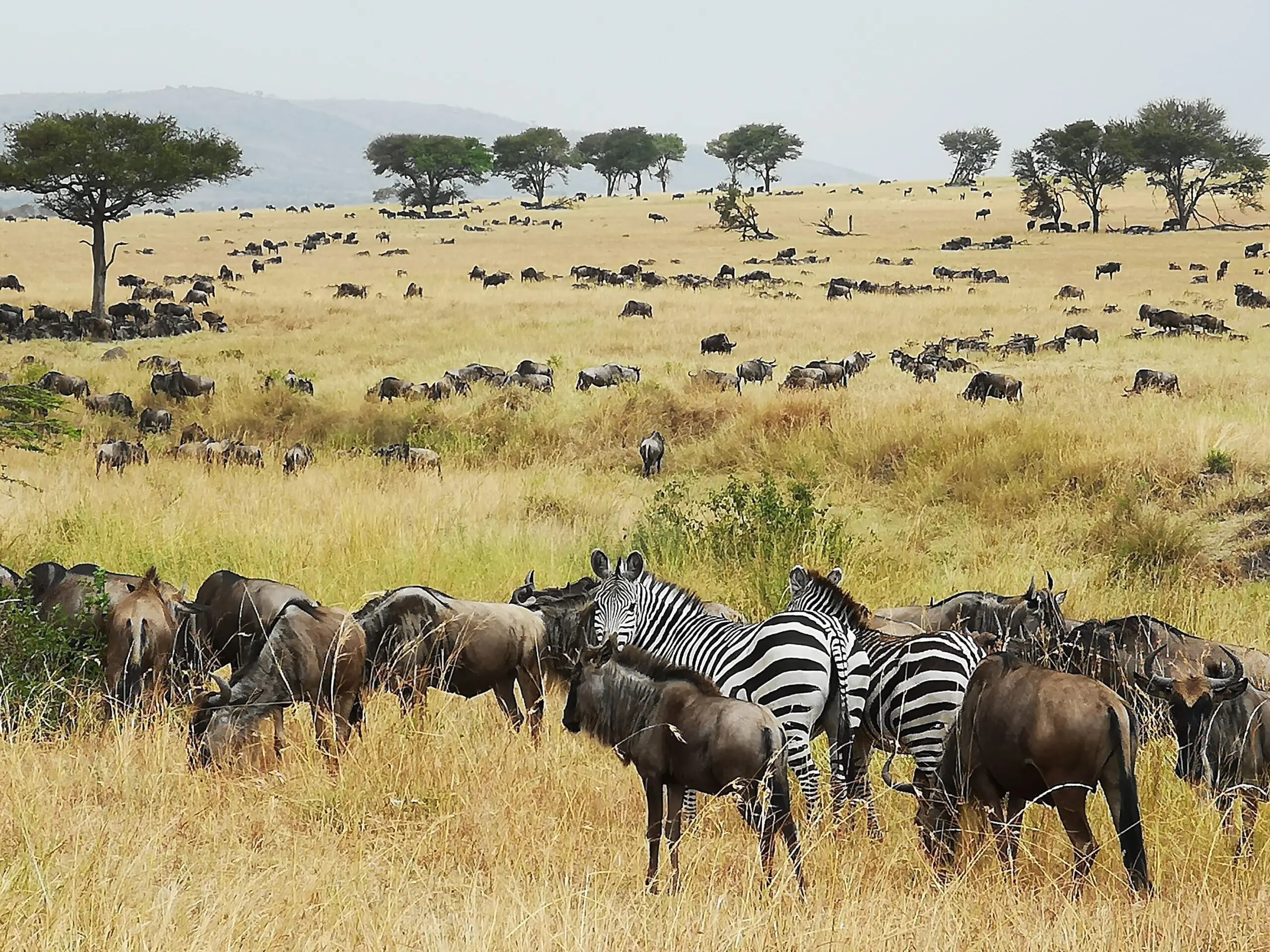

The most beautiful wildlife wonder of the world
The Great Migration is perhaps the most beautiful and extraordinary natural wonder in the world. More than 2 million wildebeests and zebras migrate through various nature reserves in Tanzania and Kenya. While the great migration mainly takes place in the Serengeti National Park area, it also passes through several other regions. In this article, we take you through the great migration and where you have the best chance to witness it.
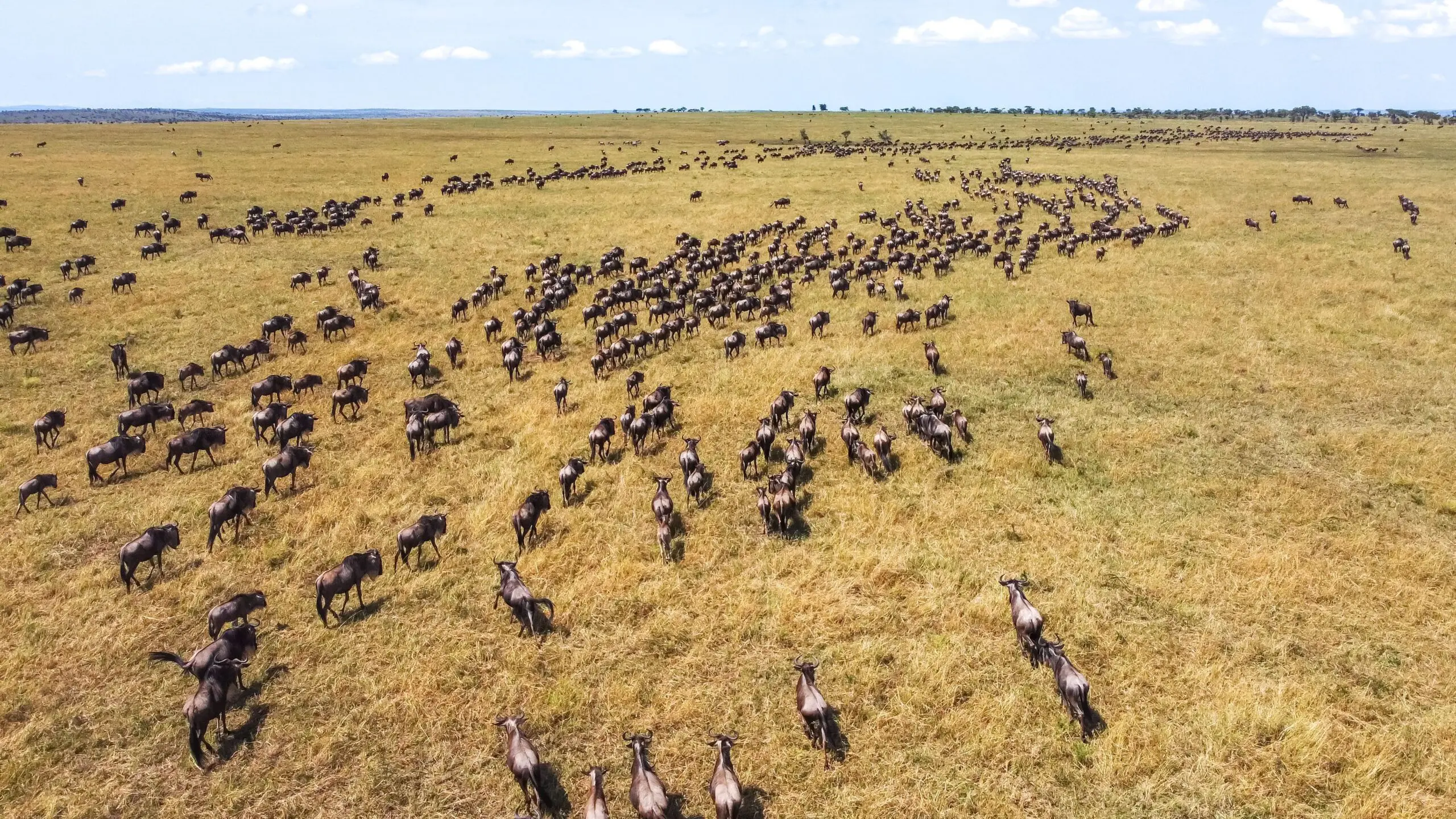
What Exactly is the Great Migration in Tanzania?
The Great Migration is the annual migration of more than two million hoofed animals, mainly wildebeests, zebras, and gazelles, crossing the African Serengeti and Masai Mara in search of fresh grass and a place to give birth to calves and foals. Witnessing this spectacular event is high on many people’s wish lists. The great migration offers remarkable sights. The groups can stretch up to 40 km long and must then cross the Mara River. You can also see many animals around these groups that see the wildebeests as prey. From hunting lions to waiting crocodiles, the great migration has it all.
“During the crossing of the Mara River, the ground literally shakes beneath your feet. The power of thousands of animals at once is something you’ll never forget.”
Where Does the Great Migration Take Place in Tanzania?
Thus, most of the great migration takes place in Serengeti National Park. In addition to this nature park, the great migration also moves through:
- Ngorongoro Conservation Area
In these areas, the great migration encounters several rivers that must be crossed. Because this is such an impressive sight, we have listed the rivers they encounter below:
- Grumeti River
- Mara River
The Great Migration: a Truly Impressive Spectacle
Throughout the entire great migration you will continue to encounter unique sights. Just imagine how the animals huddle together at night for protection from predatory animals like lions and hyenas. Or witness how the herds cross the rivers in elongated groups while crocodiles lie in wait and hippos stand by watching. Everything about the great migration is impressive, from the smells that waft through the air, the number of animals roaming around, to the trembling undergrounds as a large group thunders past. In our eyes, witnessing this natural spectacle is one of the most beautiful things to experience.
“During our safaris in July, we often see the herds waiting for minutes until one brave wildebeest takes the leap. Then the rest follow in one big, swirling mass.”
(Observation from P&W guides’ practical experience, confirmed by TANAPA.)
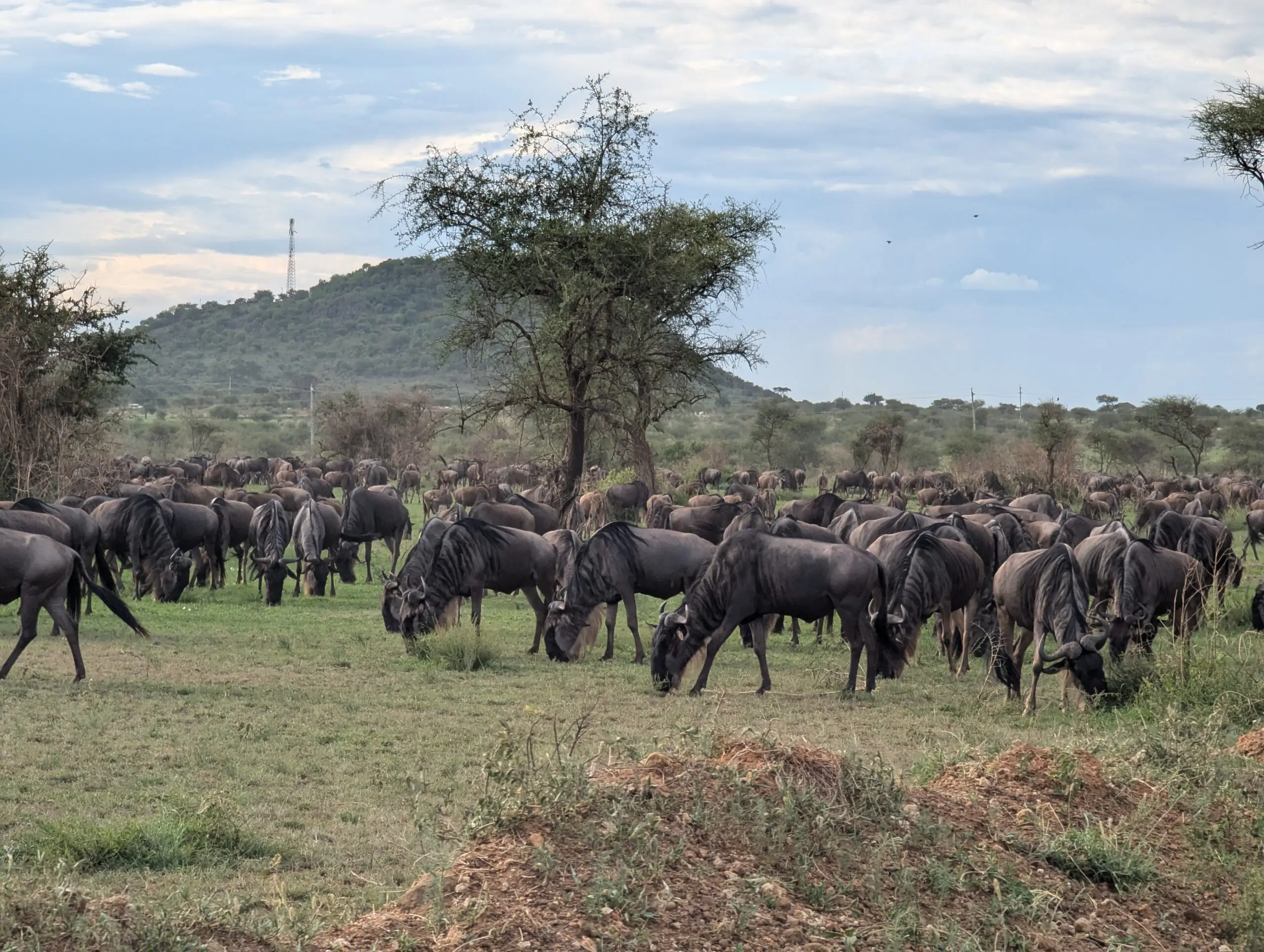
When and where Can You See the Great Migration?
To provide insight into the great migration, we will take you through where it takes place at what time of year. This migration pattern may vary, it all depends on when it starts raining.
What Happens During the Great Migration each Month?
|
Month |
Location |
Highlight |
|
Jan–Feb |
Lake Ndutu / South Serengeti |
Birthing season (500,000 calves) |
|
Jun–Aug |
West & North Serengeti |
River crossings Grumeti & Mara |
|
Sep–Nov |
North & East Serengeti |
Return journey southward |
|
Dec |
South Serengeti |
Rest phase before new calving season |
January
In January, the great migration gathers in the so-called Ndutu area. This is still officially part of Ngorongoro Conservation Area, although it is considered by many to be the South Serengeti. This area has plenty of fresh grass due to the past rainy season. This nutritious grass is good for all the female wildebeest and zebra that are about to give birth to their calves and foals. At the end of January, the first calves and foals begin to arrive and over 500,00 calves and foals are born here over the course of several weeks.
Did you know that in January
- Baby wildebeest can stand up in as little as 7 minutes
- Baby wildebeest able to ride hard after only 2 days
- 90% of all females deliver a calf
- You also have a chance of spotting small zebras in this area
February
The great migration is still in Ndutu Area during this period. February is considered one of the most important months of the great migration. Most of the 500,000 calves are born during this month. After they are born, the calves are prepared in this month for the long trek that awaits them. This month also sees many predators lurking around looking for easy meals. The calves and foals are generally not in much danger yet because there is too much food for the predators.
Did You Know that in February
- There are nearly 2 million wildebeest currently roaming this area
- There are also 800,000 zebras running through the wildebeests
March
The amount of grass in Ndutu Area is beginning to run out and the great migration is slowly departing towards Maswa Game Reserve (Southern Serengeti). The young wildebeest and zebra are also strong enough to join and the search for new food is about to begin.
April/May
In April and May, the great migrants depart for the central and western parts of the Serengeti. Here they prepare for the toughest part of their journey. This is a period when long rainstorms pour from the sky, but also the mating season begins.. This area is known as the Western Corridor, where the Grumeti River is located.
June
Large herds of wildebeest and zebra have merged into one mega herd. All because they are facing their first real challenge of the year. The crossing of the Grumeti River. A real challenge because this river is full of crocodiles and hippos.
“The tension at the Grumeti is palpable: one wrong step and the river takes them away. Yet they follow each other blindly.”
July and August
The strongest animals have overcome the first challenge, but that was not it. Indeed, in the trek to the Northern Serengeti, they encountered another obstacle: the Mara River. A notorious river known for huge numbers of crocodiles and a strong current. Crossing this river is even more dangerous than crossing the Grumeti River. When not needed, many wildebeest also decide not to cross the river. In recent years, more than half of the great migration decided it was not necessary because the grass in the area was still good enough. The safaris at this time of year are often very impressive and sensational. However, many safaris do often have a dramatic edge.. In recent years, the Mara crossing usually takes place between mid-July and late August, depending on rainfall.

September
The crossing is over and the search for new fresh grass can begin again. Many loose herds are forming across the northern Serengeti. This is a good time to spot many large herds of animals. Some of the herds also cross the border here into the Masai Mara National Park (Kenya). They do this because there is also plenty of fresh grass to be found here during this period.
October and November
During this period, the herds begin the trek south of the Serengeti again. They migrate through the eastern part of the Serengeti and they try to be in the south when the rains begin to fall again. The rain causes the fresh grass to start growing again and the pregnant females can start preparing for the birth of their calves.. This period is also called the ‘short rains season’ due to short, refreshing showers that bring new life to the landscape.
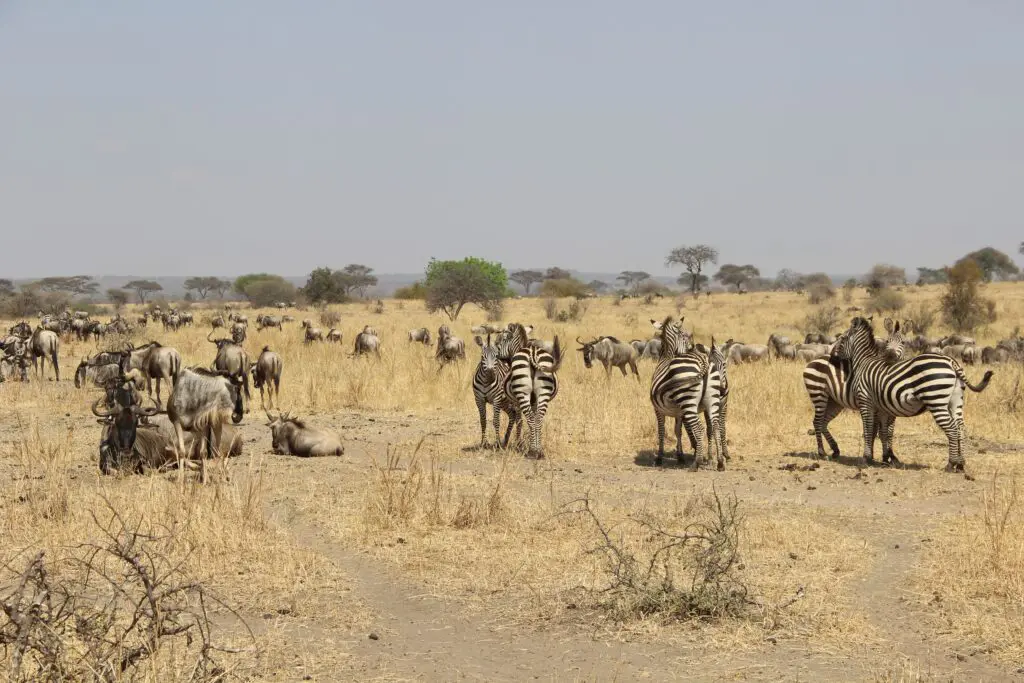
December
The great migration arrives again where they left off at the beginning of the year. Young wildebeest that survived the trek are now adult animals. The fresh juicy grass helps the pregnant females become strong enough to give birth to their calves. Predators also know that the calves are coming and these also head toward the region where the wildebeest are.
The Endless Cycle of the Great Migration
Although we see this as the start of a new great migration, of course this is not so. It is an endless circle that actually has no beginning or end. Wildebeest are animals that chase the rain throughout the year in search of fresh grass. For us, the great migration has some wonderful sights and we make sure that you can experience them with our tours. Take a look at our tours to see if there is a trip for you. All our accommodations and drivers are owned by us, ensuring a unique Tanzania safari where you can admire the great migration.
Explore tours that follow the Great Migration
Plan your migration safari
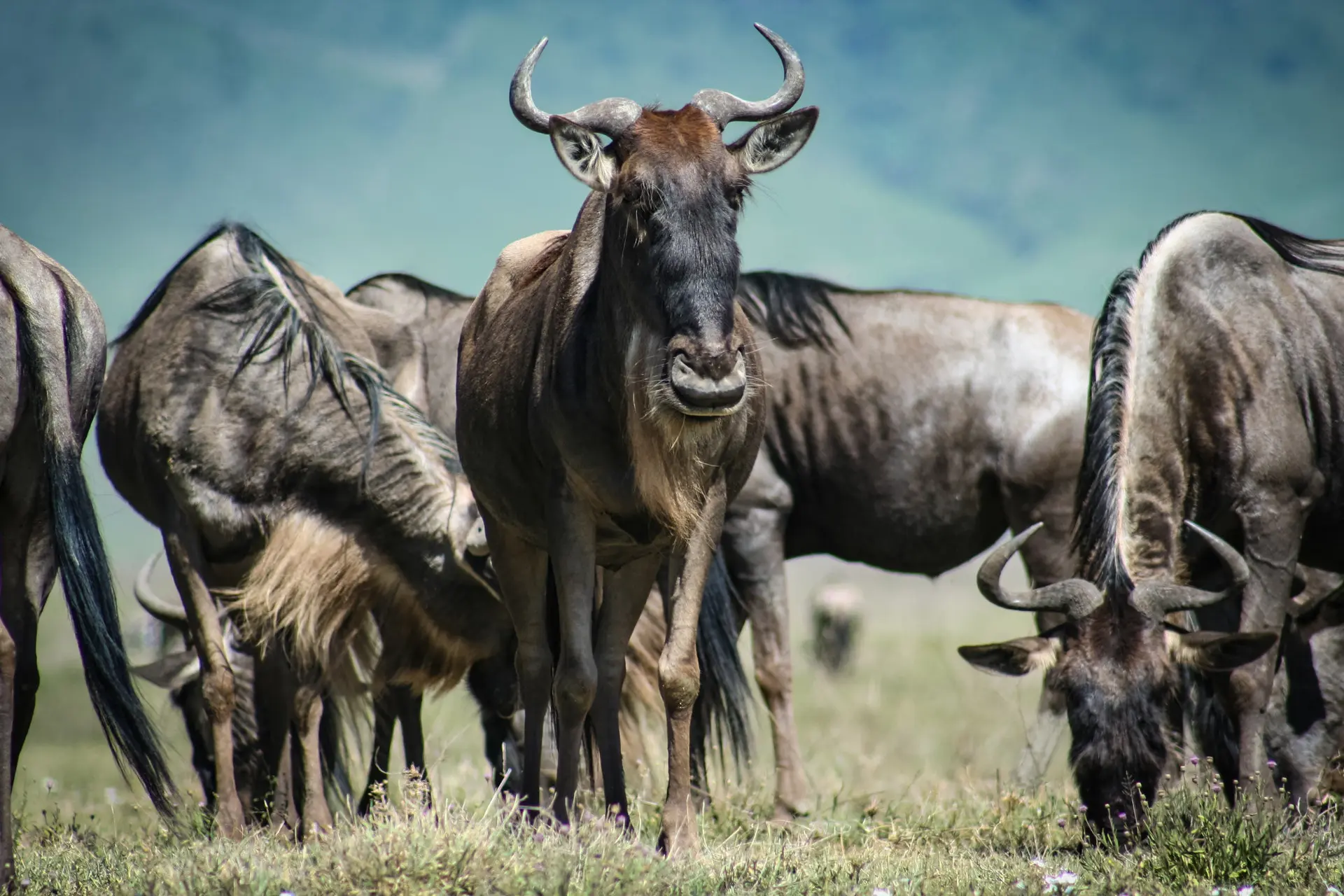
What is the Best Time to Experience the Great Migration?
In our opinion, there are a few real highlights of the great migration: the birthing season of the wildebeests and zebras and the rivers that must be crossed. But that doesn’t mean the other sights of the great migration aren’t highlights. We say: come watch the great migration all year round! Every month is unique, so whenever you come, you’ll be amazed.
Highlights at a glance:
- January – February: birthing season in the Lake Ndutu area
- June – August: spectacular river crossings
- September – November: migration through north and east Serengeti
“The Great Migration up close – breathtaking!”
Our safari was perfectly organized. Thanks to our guide Shabani, we saw the Great Migration up close – thousands of wildebeests and zebras crossing the plains, an experience we’ll never forget.
The trip was perfectly put together, the lodges were comfortable, and the team did everything to make each day special.
An unforgettable safari that exceeded all our expectations!
— Wayne M., October 2025
Is the Great Migration the Same Every Year?
No, no migration is exactly the same. The animals follow the rain and fresh grass, causing the route and pace to differ each year. The picture we sketch above is therefore a general representation of the Great Migration. Additionally, the areas where these animals roam are enormous, and it can sometimes be difficult to find them. You are therefore always somewhat dependent on a bit of luck. Fortunately, it helps that we have experienced private drivers who generally have great success in finding the great migration.
“Our private drivers often know where the herds are located thanks to years of experience and contact with rangers in the parks.”
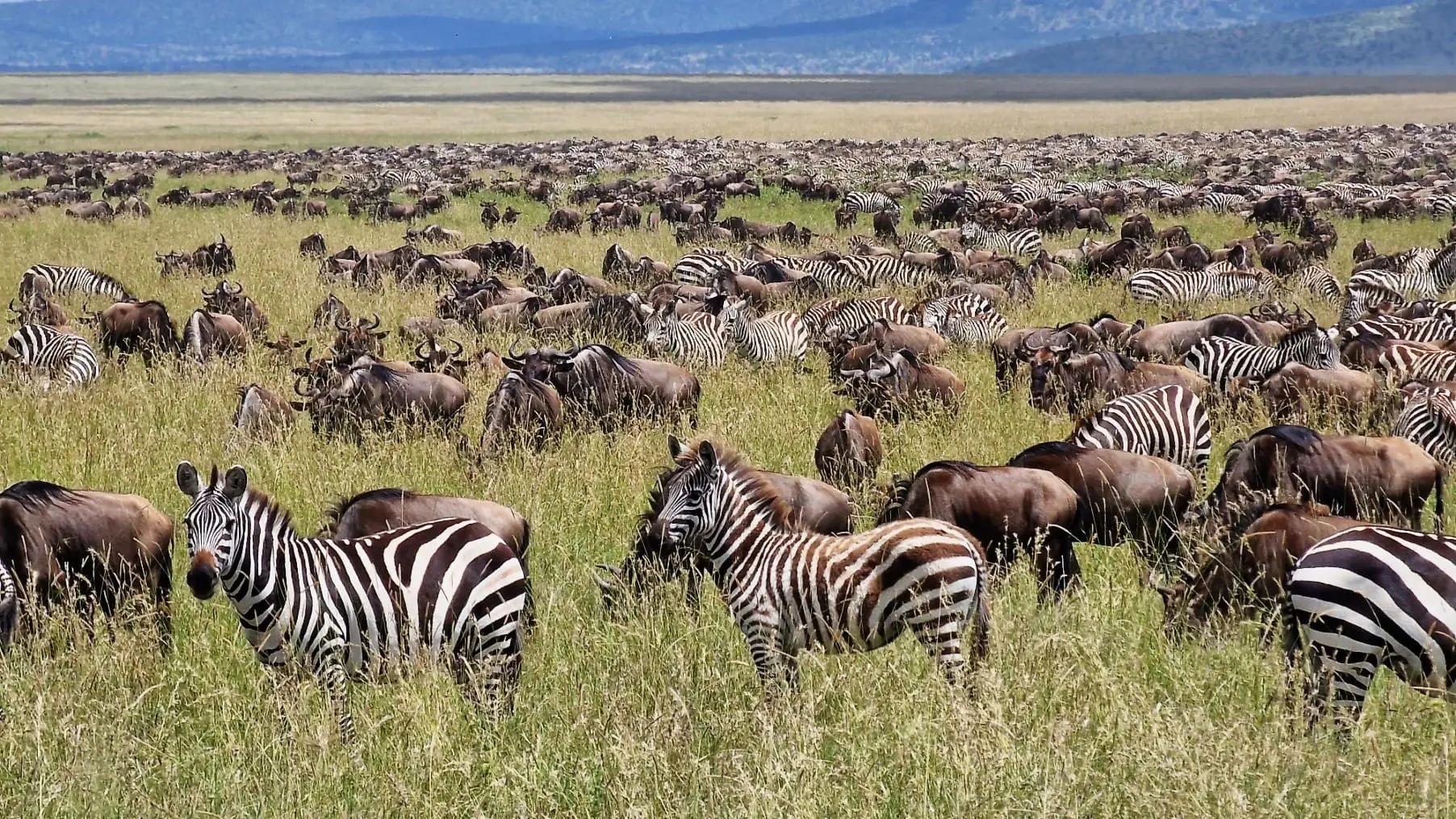
The Great Migration: facts and figures
- In total, more than 3 million animals migrate around the Serengeti.
- Over 500,000 young wildebeest are born in January and February.
- Each animal travels about 1,000 kilometers during the great migration.
- Zebras, wildebeests and gazelles can live together peacefully.
- Zebras and wildebeests work together: zebras know the route, wildebeests find water.
(Source: Serengeti.org, Great Migration Foundation, TANAPA)
Your own safari roundtrip
Do you want to see the Great Migration in real life after reading this article? We make this possible with one of our safari tours. Check our page for existing trips or contact us to see if we can create a custom trip just for you. All our accommodations and drivers are owned by us, ensuring a unique Tanzania safari where you can admire the great migration.
View our safaris around the Great Migration
How Do You Plan a Safari around the Great Migration?
The Great Migration is an experience that you must plan carefully to be in the right place at the right time. Since the herds move throughout the year, everything revolves around timing, location, and local knowledge.
Our travel experts and guides in Tanzania guide you step by step.
- Choose your ideal time of year
The Great Migration is constantly moving, so the travel period determines what you will see:
- January – February: birthing season in the Lake Ndutu area, where hundreds of thousands of calves are born.
- June – August: the famous river crossings at the Grumeti and Mara rivers — pure excitement and spectacle.
- September – November: return journey south, quieter safari period with a lot of landscape variety.
Our local teams monitor the migration daily via ranger reports and current weather data, so we can tailor your trip exactly to where the herds are located.
- Stay in our own lodges along the migration route
Paradise & Wilderness owns and operates a range of lodges and accommodations in the key areas of the Great Migration; from Lake Ndutu and Central Serengeti to the Mara region in the north.
Thanks to these locations, you always stay close to the action, in the heart of nature but with the comfort of a fixed base. Each lodge has its own character: from atmospheric campfire evenings to views of watering holes where the herds pass by.
- Travel with our local guides and private drivers
Our experienced guides and drivers live and work in the region and know exactly where the herds are located. They are in direct contact with rangers in the parks and adjust your daily routes as soon as the migration shifts. With their knowledge of behavior patterns, weather changes, and terrain, they always take you to the best spots.
Our tip: let us personally tailor your trip based on the period you are traveling.
This way, you experience the Great Migration not from a distance, but from the heart of the Serengeti, in one of our own lodges, with our own people.
Written by the safari team of Paradise & Wilderness – recognized by Travelife, with over 15 years of experience in private safaris in Tanzania.
Last updated: 2025-11-05
FAQ - the Big Five in Tanzania
The full cycle of the Great Migration takes about nine to eleven months. The herds continuously move between the grasslands in the south and the river areas in the north, depending on rainfall and food. Only in January and February do they stay longer in one place in the Lake Ndutu area due to the births.
(Source: TANAPA – Tanzania National Parks)
Yes. Although most of the migration takes place in the Serengeti National Park, parts of the herds also migrate through the Ngorongoro Conservation Area, Maswa Game Reserve and even into the Maasai Mara in Kenya. In dry years, some groups stay longer in Tanzania, while in wet years they cross the border earlier.
The iconic river crossings of the Grumeti and Mara rivers usually take place between June and August. The exact timing varies annually, as the herds follow the rain. In years with a late rainy season, some crossings may not occur until September.
There is no difference — both terms refer to the same phenomenon where millions of hoofed animals migrate through Tanzania and Kenya. The term ‘Great Trek’ is mainly used in the Netherlands, while ‘Great Migration’ is internationally common.
Choose a travel company with local guides and private drivers, who are in continuous contact with rangers in the national parks. Thanks to real-time information about rain and herd locations, they can significantly increase the chances of seeing the migration.
(Based on practical experience of Paradise & Wilderness guides)

